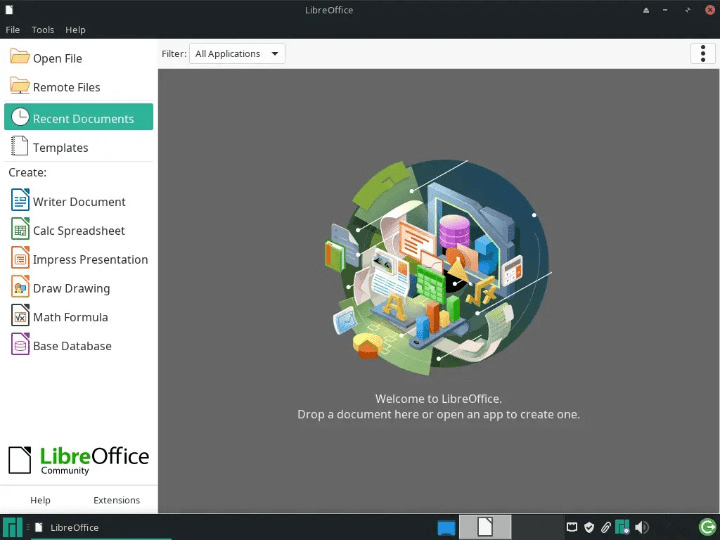How To Install LibreOffice on Ubuntu 24.04 LTS

In this tutorial, we will show you how to install LibreOffice on Ubuntu 24.04 LTS. Ubuntu 24.04, the latest long-term support (LTS) release of the popular Linux distribution, has taken the open-source community by storm. With its stability, security, and user-friendly interface, Ubuntu 24.04 has become the go-to choice for many users. One essential tool for productivity on any operating system is a reliable office suite. LibreOffice, a free and open-source office suite, is a perfect companion for Ubuntu 24.04, offering a comprehensive set of tools for creating documents, spreadsheets, presentations, and more.
This article assumes you have at least basic knowledge of Linux, know how to use the shell, and most importantly, you host your site on your own VPS. The installation is quite simple and assumes you are running in the root account, if not you may need to add ‘sudo‘ to the commands to get root privileges. I will show you the step-by-step installation of the LibreOffice on Ubuntu 24.04 (Noble Numbat). You can follow the same instructions for Ubuntu 22.04 and any other Debian-based distribution like Linux Mint, Elementary OS, Pop!_OS, and more as well.
Prerequisites
- A server running one of the following operating systems: Ubuntu and any other Debian-based distribution like Linux Mint.
- It’s recommended that you use a fresh OS install to prevent any potential issues.
- Basic familiarity with the command line interface.
- SSH access to the server (or just open Terminal if you’re on a desktop).
- An active internet connection. You’ll need an internet connection to download the necessary packages and dependencies.
- An Ubuntu 24.04 system with root access or a user with sudo privileges.
Install LibreOffice on Ubuntu 24.04 LTS
Step 1. Updating the Package Repository.
It’s always a good practice to update your Ubuntu system before installing new software. This ensures that you have the latest security patches and bug fixes. To update your system, open the terminal and run the following commands:
sudo apt update sudo apt upgrade
These commands will fetch the latest package lists and upgrade any outdated packages to their latest versions.
Step 2. Installing LibreOffice.
- Installing LibreOffice via APT
The most common and straightforward method to install LibreOffice on Ubuntu 24.04 is using the APT package manager. APT is the default package management system in Ubuntu, and it allows you to easily install, update, and remove software packages. Here’s how to install LibreOffice using APT:
sudo apt install libreoffice
Wait for the installation process to complete. APT will handle the installation and configuration of LibreOffice automatically.
Once the installation is finished, you can verify that LibreOffice is installed by running the following command:
libreoffice --version
This command will display the version number of LibreOffice installed on your system.
- Installing LibreOffice via Snap
Snap is a package management system developed by Canonical, the company behind Ubuntu. Snap packages are self-contained and include all the necessary dependencies, making them easy to install and use across different Linux distributions. Here’s how to install LibreOffice using Snap:
sudo apt install snapd
Once Snap is installed, you can install LibreOffice using the following command:
sudo snap install libreoffice
Wait for the installation process to complete. Snap will handle the installation and configuration of LibreOffice automatically.
After the installation is finished, you can launch LibreOffice from the application menu or by running the command libreoffice in the terminal.
One advantage of using Snap packages is that they are automatically updated in the background, ensuring that you always have the latest version of LibreOffice. However, Snap packages may have slightly longer startup times compared to traditional APT installations.
- Installing LibreOffice via Flatpak
Flatpak is another package management system that allows you to install and run applications in a sandboxed environment. Flatpak packages are self-contained and include all the necessary dependencies, making them portable across different Linux distributions. Here’s how to install LibreOffice using Flatpak:
sudo apt install flatpak
Add the Flathub repository, which is the main source for Flatpak applications, by running the following command:
flatpak remote-add --if-not-exists flathub https://flathub.org/repo/flathub.flatpakrepo
Once the Flathub repository is added, you can install LibreOffice using the following command:
flatpak install flathub org.libreoffice.LibreOffice
Wait for the installation process to complete. Flatpak will handle the installation and configuration of LibreOffice automatically.
After the installation is finished, you can launch LibreOffice from the application menu or by running the command flatpak run org.libreoffice.LibreOffice in the terminal.
Flatpak packages run in a sandboxed environment, which provides an additional layer of security. However, this may result in slightly longer startup times and increased disk space usage compared to traditional APT installations.
Step 3. Launching LibreOffice.
You can launch LibreOffice from the application menu by searching for “LibreOffice” or by clicking on the LibreOffice icon. Alternatively, you can launch specific components of LibreOffice from the terminal using the following commands:
- Writer:
libreoffice --writer - Calc:
libreoffice --calc - Impress:
libreoffice --impress - Draw:
libreoffice --draw - Base:
libreoffice --base - Math:
libreoffice --math

Congratulations! You have successfully installed LibreOffice. Thanks for using this tutorial for installing LibreOffice on the Ubuntu 24.04 LTS system. For additional help or useful information, we recommend you check the official LibreOffice website.